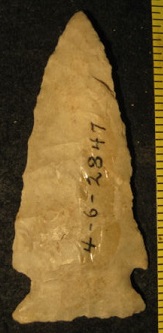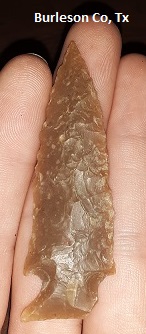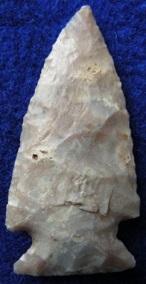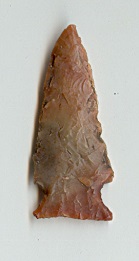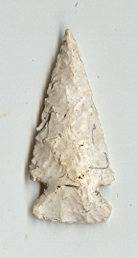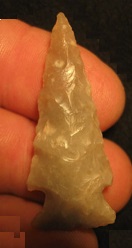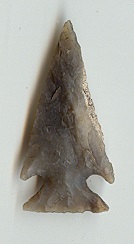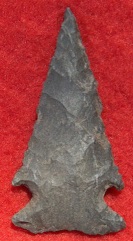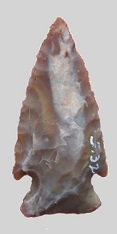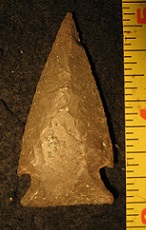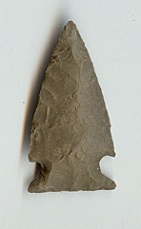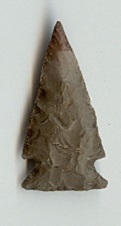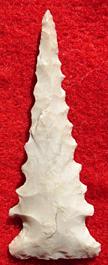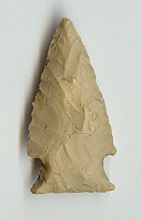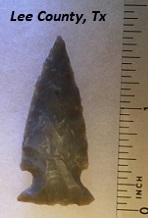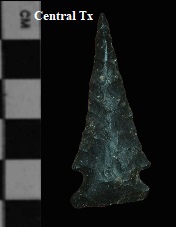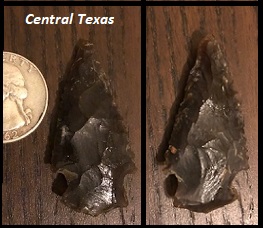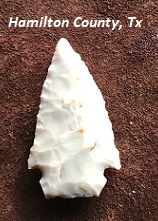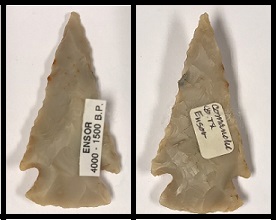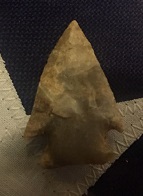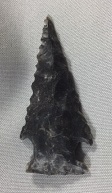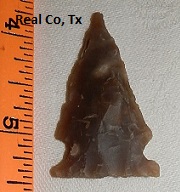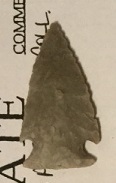Outline is Representative of Size and Shape:
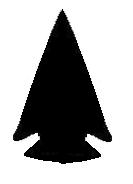
Name Details:
Identified By: E. O. Miller an Edward B. Jelks
Named For:
Date Identified: 1952
Type Site: Belton Reservoir, Coryell County, Texas
Identified By: E. O. Miller an Edward B. Jelks
Named For:
Date Identified: 1952
Type Site: Belton Reservoir, Coryell County, Texas
Point Validity:
Valid type
Miller was an archaeologist who conducted many excavations during the dam construction projects. Jelks was a distinguished anthropologist and helped organize the newly formed Department of Anthropology at Illinois State University where he was a Professor. His work in Texas furthered the understanding of Texas archeology and was a founding force for the Society of Historical Archeology. This point was named in a professional publication and has many professional references. This is a valid type.
Miller was an archaeologist who conducted many excavations during the dam construction projects. Jelks was a distinguished anthropologist and helped organize the newly formed Department of Anthropology at Illinois State University where he was a Professor. His work in Texas furthered the understanding of Texas archeology and was a founding force for the Society of Historical Archeology. This point was named in a professional publication and has many professional references. This is a valid type.
Ensor Corner Notch
AKA: Juno Broad Base (Kelley, 1947)Cluster:
Description of Physical Characteristics and Flaking Pattern:
This is a thin medium to large triangular corner notch point with a flattened cross section. The blade is primarily straight, but may vary to slightly excurvate, and could be finely serrated. Re-sharpened examples may have an incurvate or recurvate blade. The shoulders are primarily barbed, but may take on a horizontal appearance especially in re-sharpened examples. The notched may are usually moderately shallow leaving a broad neck with a stem that is broad, expanding, and usually the same width as the shoulders. Suhm and Krieger (1954) note that even when the base is narrower than the shoulders, the shallower notches and broad neck would be indicative of this type. The base may vary from slightly concave to slightly convex. This point has a random flaking pattern.
Size Measurements:
Total Length - 30 to 70 mm (average 50 mm), Stem Length - 6 to 11 mm, Width at shoulders - 20 to 30 mm, Neck Width - 13 to 18 mm, Stem Width - 20 to 28 mm
Total Length - 30 to 70 mm (average 50 mm), Stem Length - 6 to 11 mm, Width at shoulders - 20 to 30 mm, Neck Width - 13 to 18 mm, Stem Width - 20 to 28 mm
Commonly Utilized Material:
Additional Comments:
Dan R. Davis (1991), divides these points into three sub-categories which include: Type I - Concave Base, Type II - Slight Convex Base, and Type III - Straight Base. Davis does not recognize the split stem variety.
,br /> Both Ensor and Frio type points were originally classified as Ensor points at Belton Reservoir by Miller and Jelks. Suhm et al (1954) re-defined the Ensor type excluding the Frio points from the definition of the Ensor type. Many collector sources consider Frio type points associated with Ensor points as Ensor Split Stem or Ensor Frio points. The primary difference between the Ensor Frio and the Frio type is that the Ensor Frio has a narrow diagonal notch with a slightly barbed shoulder while the Frio type has a wider parallel notch with a shoulder that is generally at a slight upward angle. The basal edge between the two type generally differ with the Ensor Frio base having a notched or V appearance and the Frio having a recurvate basal edge.
J.C. Kelley (1947), identified the Juno Broad Base type which is noted for having a base that extends past the shoulders. This type has a shallow notch and a broad neck as described as an Ensor point by Suhm and Kreiger (1954). They note that the Juno Broad Base as described by Kelley falls within the normal variation of the Ensor type and include it in their book as an Ensor.
Suhm and Kreiger (1954) note that these points are similar to Marcos points. They distinguish this type by the Marcos point having longer deeper notches that form a narrower neck than seen on this type. Also, the base is always narrower than the shoulders on the Marcos point.
Dan R. Davis (1991), divides these points into three sub-categories which include: Type I - Concave Base, Type II - Slight Convex Base, and Type III - Straight Base. Davis does not recognize the split stem variety.
,br /> Both Ensor and Frio type points were originally classified as Ensor points at Belton Reservoir by Miller and Jelks. Suhm et al (1954) re-defined the Ensor type excluding the Frio points from the definition of the Ensor type. Many collector sources consider Frio type points associated with Ensor points as Ensor Split Stem or Ensor Frio points. The primary difference between the Ensor Frio and the Frio type is that the Ensor Frio has a narrow diagonal notch with a slightly barbed shoulder while the Frio type has a wider parallel notch with a shoulder that is generally at a slight upward angle. The basal edge between the two type generally differ with the Ensor Frio base having a notched or V appearance and the Frio having a recurvate basal edge.
J.C. Kelley (1947), identified the Juno Broad Base type which is noted for having a base that extends past the shoulders. This type has a shallow notch and a broad neck as described as an Ensor point by Suhm and Kreiger (1954). They note that the Juno Broad Base as described by Kelley falls within the normal variation of the Ensor type and include it in their book as an Ensor.
Suhm and Kreiger (1954) note that these points are similar to Marcos points. They distinguish this type by the Marcos point having longer deeper notches that form a narrower neck than seen on this type. Also, the base is always narrower than the shoulders on the Marcos point.
Distribution: 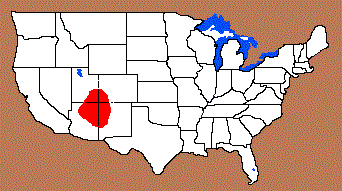

Distribution Comments:
This point is primarily found in from central Texas into the lower Pecos River valley and throughout the Guadalupe River valley. This point is found with diminished frequency into the Sabine River Valley of eastern Texas and western Louisiana and into Arkansas and Oklahoma. Frequency diminishes into southern Tamaulipas.
This point is primarily found in from central Texas into the lower Pecos River valley and throughout the Guadalupe River valley. This point is found with diminished frequency into the Sabine River Valley of eastern Texas and western Louisiana and into Arkansas and Oklahoma. Frequency diminishes into southern Tamaulipas.
Age / Periods:
Date: 2,200 - 1,400 B.P.
Cultural Period: Transitional Archaic
Glacial Period: Roman Warm
Culture:
Date: 2,200 - 1,400 B.P.
Cultural Period: Transitional Archaic
Glacial Period: Roman Warm
Culture:
Age Details:

